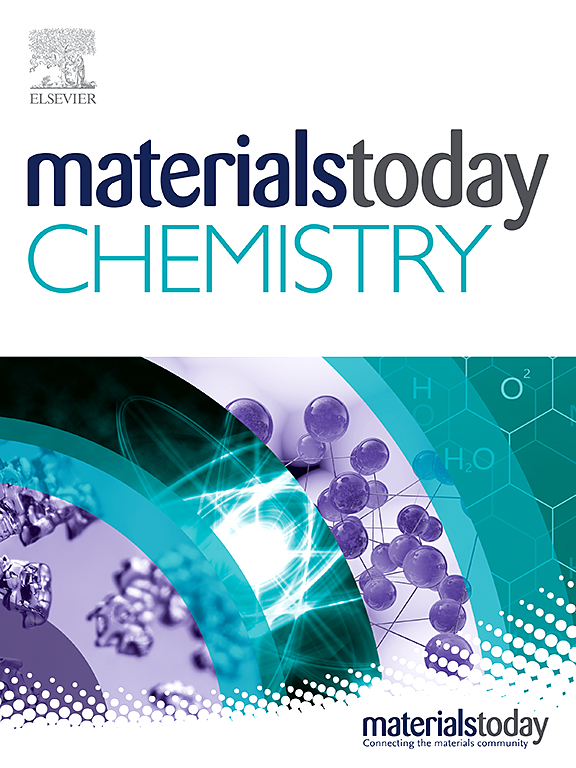Ultra-stretchable and adhesive hydrogel based on double network structure as flexible strain sensor for human motion detection
IF 6.7
2区 化学
Q1 CHEMISTRY, MULTIDISCIPLINARY
引用次数: 0
Abstract
In recent years, conductive hydrogels were widely applied as flexible strain sensor due to its outstanding stretchability, high flexibility and conductivity. However, most conductive hydrogels would reduce the sensitivity and accuracy of hydrogel-based strain sensor for the lack of self-adhesion. Herein, a highly stretchable and excellent adhesive hydrogel based on chitosan network and ionic liquid crosslinking network was prepared. Chitosan (CS) worked as network skeleton, which could enhance the mechanical properties of hydrogel by participating in the construction of double network structure. Furthermore, dimethylaminoethyl methacrylate maleate (DM-M) as cross-linker, the hydrogel was imparted with high ionic conductivity (0.29 S/m) while it also enhanced the mechanical properties of the hydrogel. The ionic bonding conferred high toughness to the hydrogel for avoiding stress concentration during tensile process. Additionally, the hydrogel could form strong adhesion to a variety of substrate surfaces through electrostatic interaction, hydrogen bond and metal complexation. Meanwhile, the hydrogel remained strong adhesion under different pH, solvent and temperature condition. Therefore, the hydrogel with excellent adhesive property, mechanical properties and high electrical conductivity have been designed as flexible strain sensor, which could detect limb movement and physiological signals with real-time feedback electrical signals. Thus, this highly stretchable, tough and adhesive hydrogel based on double network structure would promote the development of flexible electronic device.基于双网络结构的超弹力和粘性水凝胶作为柔性应变传感器用于人体运动检测
近年来,导电水凝胶因其出色的拉伸性、高柔韧性和导电性被广泛应用于柔性应变传感器。然而,大多数导电水凝胶由于缺乏自粘性,会降低水凝胶应变传感器的灵敏度和准确性。在此,我们制备了一种基于壳聚糖网络和离子液体交联网络的高拉伸性和优异粘附性的水凝胶。壳聚糖(CS)作为网络骨架,通过参与双网络结构的构建提高了水凝胶的机械性能。此外,甲基丙烯酸马来酸二甲胺基乙酯(DM-M)作为交联剂,在赋予水凝胶高离子传导性(0.29 S/m)的同时,还增强了水凝胶的机械性能。离子键赋予了水凝胶高韧性,避免了拉伸过程中的应力集中。此外,水凝胶还能通过静电作用、氢键和金属络合作用与各种基底表面形成强大的粘附力。同时,水凝胶在不同的 pH 值、溶剂和温度条件下都能保持较强的粘附性。因此,该水凝胶具有优异的粘附性、机械性能和高导电性,可设计成柔性应变传感器,通过实时反馈电信号来检测肢体运动和生理信号。因此,这种基于双网络结构的高拉伸性、高韧性和高粘性水凝胶将促进柔性电子设备的发展。
本文章由计算机程序翻译,如有差异,请以英文原文为准。
求助全文
约1分钟内获得全文
求助全文
来源期刊

Materials Today Chemistry
Multiple-
CiteScore
8.90
自引率
6.80%
发文量
596
审稿时长
33 days
期刊介绍:
Materials Today Chemistry is a multi-disciplinary journal dedicated to all facets of materials chemistry.
This field represents one of the fastest-growing areas of science, involving the application of chemistry-based techniques to the study of materials. It encompasses materials synthesis and behavior, as well as the intricate relationships between material structure and properties at the atomic and molecular scale. Materials Today Chemistry serves as a high-impact platform for discussing research that propels the field forward through groundbreaking discoveries and innovative techniques.
 求助内容:
求助内容: 应助结果提醒方式:
应助结果提醒方式:


